 Are you interested in working with influential social media personalities? Not sure where to start?
Are you interested in working with influential social media personalities? Not sure where to start?
In this article, you'll find three tools to help you manage influencer relationships and campaigns.
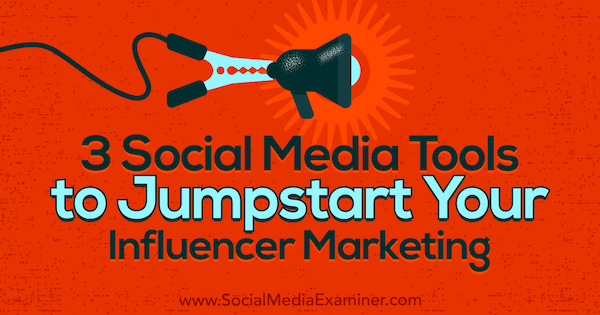
#1: Partner With Legitimate Influencers Using HYPR
One of the biggest risk factors in influencer marketing is fraud, where fake influencers buy followers in order to appear influential. That's also one of the reasons brands don't see positive results from their influencer marketing campaigns. Once an isolated issue, influencer fraud has become a real concern in recent years.
To empower your influencer marketing efforts in the coming year, you need new metrics and tools to discover real influencers to work with.
HYPR is an advanced influencer search engine that helps you find real social influencers across major platforms: Facebook, Twitter, Instagram, Pinterest, and YouTube. HYPR organizes social media information to match brands with niche influencers within targeted audience demographics.
When you sign up, HYPR lets you explore the platform with a free trial. After that, you'll need to upgrade to one of the three subscription plans, depending on your business's needs.
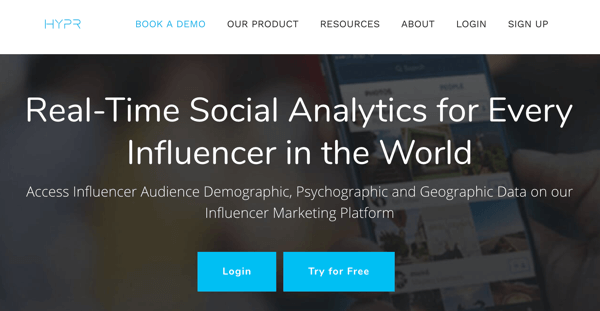
Discover Your Niche Influencers
The first step is to use your main keywords to find your influencers. From there, you can filter results by:
- Audience (demographics of people following and interacting with your niche influencers).
- Influencer (influencer's age, location, gender, etc.). For example, if your influencer marketing campaign only targets women, you can filter your search to women only.
- Platform (for instance, if you're planning a video campaign, you can choose to see only YouTube influencers).
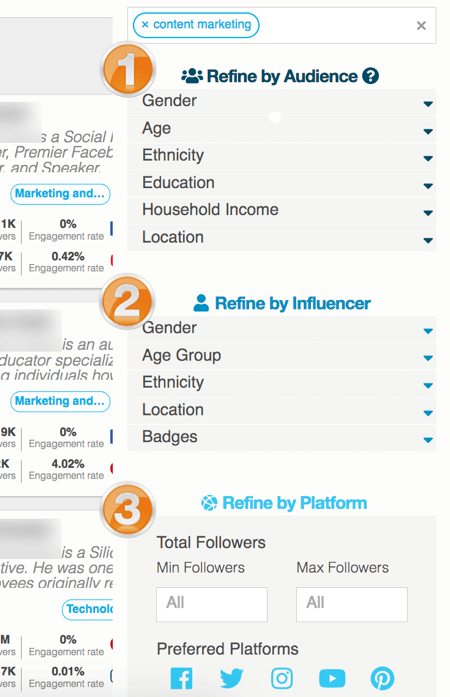
The key power of the discovery tool is the ability to use these search filters to find your best-match influencers that most closely fit your campaign goals (e.g., based on your target customer age group, gender, income, location, etc.).
Moreover, you can see important details (description and key audience interests) and metrics (number of followers and subscribers across all social media platforms where they've built influence) of each influencer at a glance. This allows you take more important metrics into account like engagement, audience type, and so on, to help you connect with real influencers.

HYPR lets you sort results by various engagement metrics including the number of comments, likes, and shares per post. When you're happy with the results, you can save any of your search settings.
Get World-Class Marketing Training — All Year Long!
Are you facing doubt, uncertainty, or overwhelm? The Social Media Marketing Society can help.
Each month, you’ll receive training from trusted marketing experts, covering everything from AI to organic social marketing. When you join, you’ll also get immediate access to:
- A library of 100+ marketing trainings
- A community of like-minded marketers
- Monthly online community meetups
- Relevant news and trends updates
Each influencer's profile contains more insight into key metrics, helping you make an informed decision. You can see how many recent interactions they received at their major channels and their personal brand strength (how frequently their name is searched for in Google, based on Google Trends).
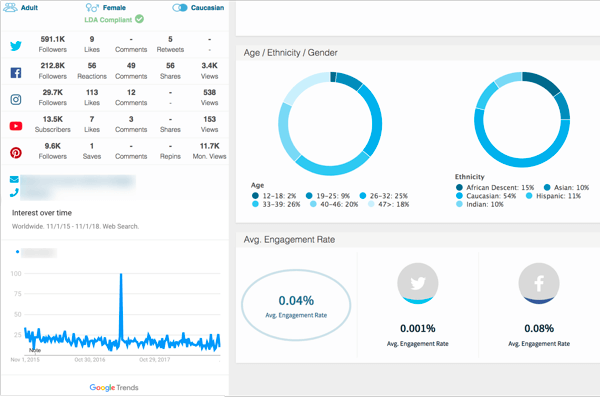
Additionally, you can view their audience's demographic details.
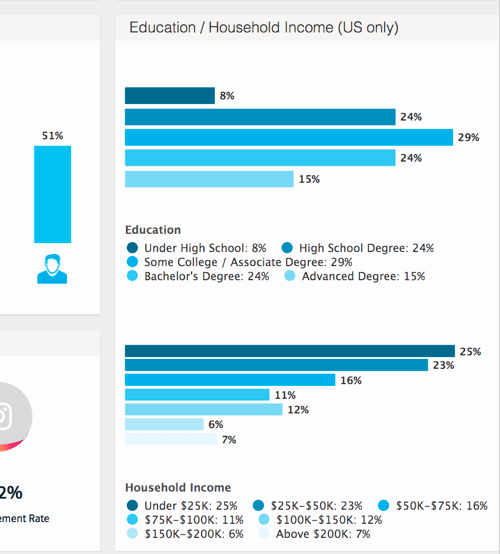
Organize Your Niche Influencers
When you start reviewing your search results, you can:
- Leave notes to point out something specific (these notes will later be populated in the PDF downloads, too).
- Sort your influencers into various lists to form a more organized plan for your future campaigns.
Here are a few ideas for those influencer marketing lists:
- Favorites: These are influencers you plan to keep in touch with long-term, no matter which particular campaign you're planning. Refine this list depending on how many interactions you or your team receive from each influencer. You may find some influencers unwilling to respond, so it doesn't make sense to keep trying to interact with them.
- Topic/Client: This type of list applies mostly to agencies and social media marketing service providers. Keep your influencers organized based on each client niche to better target your campaigns.
- Campaign: Make a list for a particular campaign you're planning.
You can share any list by email or export it for later reference. The detailed PDF export contains the full profile of each listed influencer, which makes it a very useful document to distribute to your team members.

#2: Develop Employee Influencers With Smarp
An important element of influencer marketing that most brands are missing is growing your own in-house influencers. If your previous influencer marketing campaigns have relied solely on external influencers, think about changing the focus to grow your own brand's collective social media influence. Think about it:
- Your team members are with you long-term, so that's an investment in your brand's future.
- You're already paying them, so it may be more cost-effective.
- Your employees “get” your messaging. And hopefully they're as excited about your business's future as you are. You can't fake that!
- Your employees know your products, so they'll be able to put them in the most fitting context.
- Your employees will love that you're helping them become industry thought leaders, so they'll be more motivated than external influencers.
Smarp is an employee advocacy platform that can help you encourage your employees to interact with your identified niche influencers on social media, and more importantly, grow your own in-house influencers. You can try it out with a 14-day free trial. After that, you'll need to upgrade to one of the paid plans.
With Smarp, you can create a unified news feed of all of your brand assets and external niche resources for your employees to help share on social media. There's also a smartphone app (iOS and Android) for on-the-go sharing and engaging.

Smarp's built-in point system is useful for motivating more of your employees to engage. Points are assigned when employees:
- Click and/or share your updates.
- Invite members to join.
- Suggest more links for adding to the company news feed.
Not only will the point system gamify the whole company-sharing routine (through the built-in leaderboard), but it's also useful for incentivizing team members to actively participate in the in-house social media marketing.
All of the team members can authenticate their social media accounts (Facebook, LinkedIn, Twitter, Instagram, etc.) to easily share your company updates on their public feeds.


Discover Proven Marketing Strategies and Tips
Want to go even deeper with your marketing? Check out the Social Media Marketing Podcast! Publishing weekly since 2012, the Social Media Marketing Podcast helps you navigate the constantly changing marketing jungle, with expert interviews from marketing pros.
But don’t let the name fool you. This show is about a lot more than just social media marketing. With over 600 episodes and millions of downloads each year, this show has been a trusted source for marketers for well over a decade.
Encourage Employees to Interact With Influencers (Especially on Twitter)
The path from a contact to a successful business partnership includes many important touchpoints along the way, especially with influencers who have a lot on their plates already.
So how do you get your brand noticed by influencers and turn those influencers into your brand advocates? Your team is the perfect answer because influencers are human beings and they prefer to interact with real people, not just brands and account managers. With Smarp, you can:
- Notify all team members immediately (and send push notifications on mobile devices).
- Decide how many points to assign for live shares.
- Enable the sharing of networks and messages. Administrators can pre-write optional messages that will go live on social media.
The last point is important for Twitter sharing because you can include tagged influencers in your messages so they show up in public tweets from your employees. Here's what it looks like to add a URL:

The resulting tweet is shown below. As you can see, all of the tagged Twitter usernames are in the tweet.
Not only will this help your brand get noticed by influencers, but it will also get your team out there. The more your team successfully engages with influencers, the faster some of them will become the influencers' peers, growing your collective in-house social media clout.
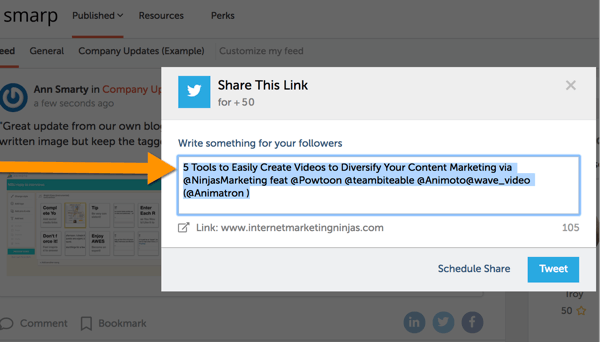
Grow In-House Social Media Influencers
Apart from encouraging your team members to increase the number of meaningful touchpoints your brand has with outside influencers, Smarp also helps you identify internal talent and grow your own in-house influencers.
SmarpScore (currently in beta) aims to motivate your team members to be more active on social media and build their social media engagement. Each employee's score is calculated based on these criteria:
- SmarpScore takes into account the number of interactions (likes, reshares, comments, retweets, etc.) generated from your employees' Smarp-driven social media updates. Note: Quality shares are valued over quantity. To illustrate, 10 tweets that generated 100 retweets will have more influence than 1,000 tweets that generated 100 retweets.
- Last week's shares influence the score more than shares from last month. Shares from over 6 months ago have no effect at all.
- SmarpScore considers the performance of other users as well (all of the team members in your company are compared to one another, so those metrics aren't isolated).

The scoring system is a great way to incentivize social media influence growth within your company and encourage employees to strive for meaningful interactions.
After using the platform for a few months, view your Smarp Insights to identify your most active employees who are likely to become social media influencers. You may want to work with those employees more closely (using internal training) to help them steadily build their social media influence and use it to amplify your brand's voice.
#3: Evaluate Influencer Marketing Campaigns With Oribi Analytics
Once your social media influencer campaign is up and running, how do you monitor and evaluate its effectiveness? If you've previously focused on traffic and keywords, you may be discouraged because influencer marketing traffic isn't an accurate metric. You may have seen a substantial increase in clicks during the campaign, but the momentum dies out shortly after your campaign ends.
Traditional traffic analytics platforms aren't that reliable for measuring and evaluating the impact of influencer marketing campaigns. Instead, you may want to refocus your efforts on actual business value and not just traffic. You need a better way to correlate influencer posts with micro-conversions and easily compare the business performance that different influencers are driving for you.
You may be trying to do that with Google Analytics events and goals but they're not easy to set up. A better option might be to have Oribi do the work for you. With this tool, you get clear-cut targeted insights focusing on each of your marketing campaigns.
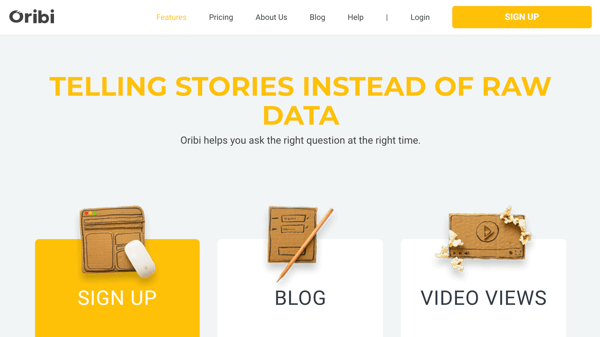
To set it up, create a free Oribi account, install a unique code, and give it some time to collect data. For this reason, it's a good idea to get it going prior to the campaign launch. Paid plans start at $29/month.
Monitor Your Influencer Campaign Goals
Once Oribi starts collecting data, you can pin at least three actions you're focusing on. For example, I've specified three events that are important to me:
- Clicks on Subscribe to My Premium Course buttons (the primary goal).
- Clicks through to the Become Ann's Premium Subscriber link in the main navigation.
- Clicks through to my Contact Ann link in the main navigation. (This is an alternative action mostly showing how interested social media users are in learning more about me.)

Pinning these three events tells Oribi that I want to focus on those events in all of the reports.

Oribi allows you to follow the performance of your social media and influencer marketing campaigns closely so you can adjust your tactics for the future.
Check out the Visitor Journeys section to get a more detailed view of your site users and a better understanding of what brought them to your defined events.
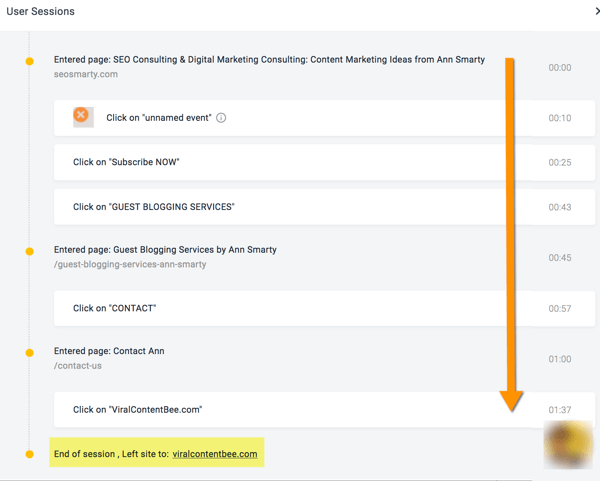
As you can see, Oribi lets you view each customer's journey in detail, allowing you to better understand where they land and which actions they perform after that.
Now imagine you have these insights immediately after an influencer's post, or review mentioning your product, goes live. Proceed to Top Visits inside Oribi and closely follow each of those visits driven by an influencer's activity:
- Which button did they click? And why might they have failed to subscribe?
- Where did they go next? And what may have distracted them?
- Why did they end up performing a certain action? And how may you serve them better in the future?
Compare the Effectiveness of Your Influencer Marketing Campaigns
Finally, for every influencer campaign you're planning, create a funnel to get a better understanding of how well your landing page funnels visitors into the conversion process. This will allow you to compare several influencer outreach campaigns side by side.
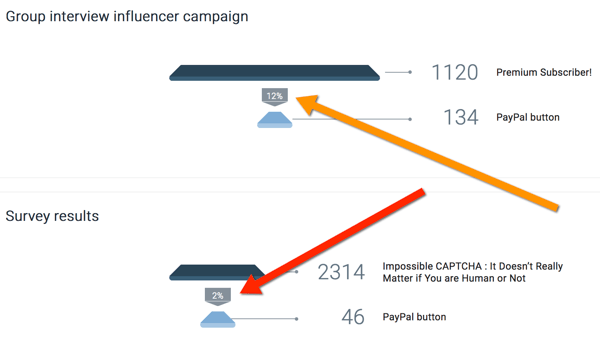
Conclusion
Influencer marketing is one of the most creative digital marketing arenas. There are no cookie-cutter approaches. It takes a good team, a lot of time, and many careful attempts to find tactics and tricks that prove effective for your brand.
Hopefully the three tools above will breathe fresh air into your influencer marketing process and help you innovate and empower your strategy.
What do you think? Which tools are you using to create more effective influencer marketing campaigns? Please share your thoughts in the comments!
More articles about influencer marketing:
- Learn how to measure the results of your influencer marketing campaigns.
- Discover how to use influencer marketing to amplify your message.
- Find out how to use influencer marketing to scale your social media results.
Attention Agency Owners, Brand Marketers, and Consultants

Introducing the Marketing Agency Show–our newest podcast designed to explore the struggles of agency marketers.
Join show host and agency owner, Brooke Sellas, as she interviews agency marketers and digs deep into their biggest challenges. Explore topics like navigating rough economic times, leveraging AI, service diversification, client acquisition, and much more.
Just pull up your favorite podcast app, search for Marketing Agency Show and start listening. Or click the button below for more information.

